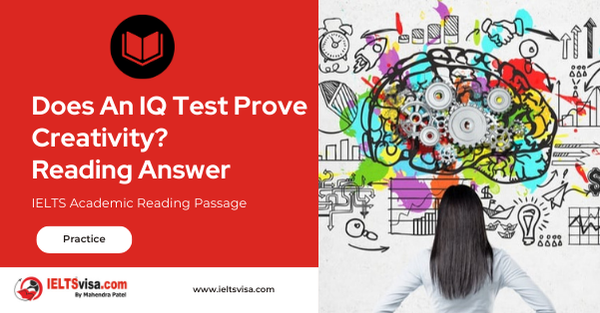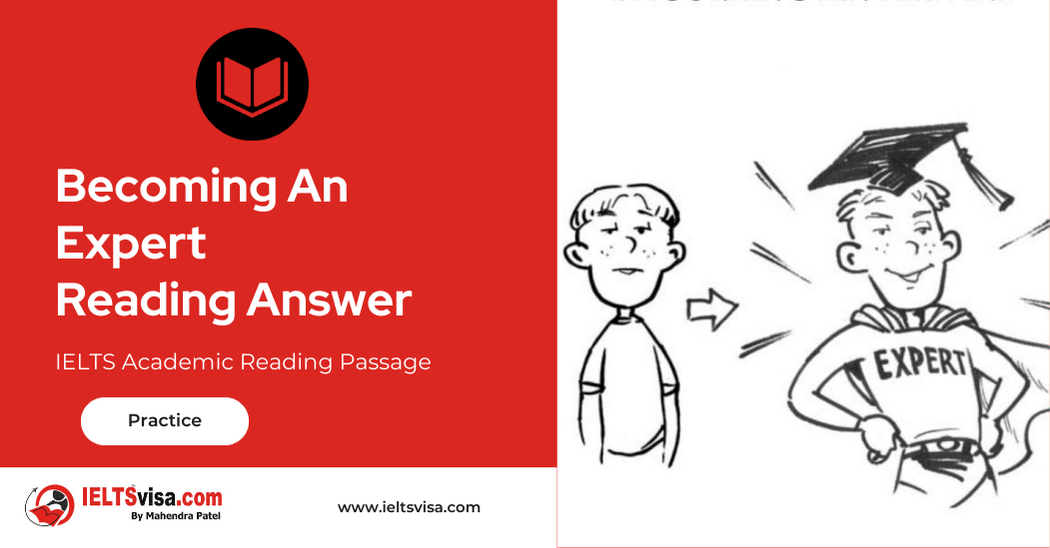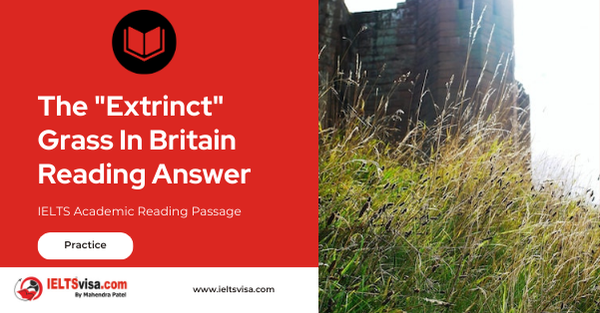Does An IQ Test Prove Creativity? Reading Answer
IELTS Academic Reading Passage
Does An IQ Test Prove Creativity?
PASSAGE
A
In the early 1970s, creativity was still seen as a type of intelligence. But when more subtle tests of IQ and creative skills were developed in the 1970s, particularly by the father of creativity testing, Paul Torrance, it became clear that the link was not so simple. Creative people are intelligent, in terms of IQ tests at least, but only averagely or just above. While it depends on the discipline, in general beyond a certain level IQ does not help boost creativity; it is necessary but not sufficient to make someone creative.
B
Because of the difficulty of studying the actual process, most early attempts to study creativity concentrated on personality. According to creativity specialist Mark Runco of California State University, Fullerton, the “creative personality” tends to place a high value on aesthetic qualities and to have broad interests, providing lots of resources to draw on and knowledge to recombine into novel solutions. “Creatives” have an attraction to complexity and an ability to handle conflict. They are also usually highly self-motivated, perhaps even a little obsessive. Less creative people, on the other hand, tend to become irritated if they cannot immediately fit all the pieces together. They are less tolerant of confusion. Creativity comes to those who wait, but only to those who are happy to do so in a bit of a fog.
C
But there may be a price to pay for having a creative personality. For centuries, a link has been made between creativity and mental illness. Psychiatrist Jamison of Johns Hopkins University in Baltimore, Maryland, found that established artists are significantly more likely to have mood disorders. But she also suggests that a change of mood state might be the key to triggering a creative event, rather than the negative mood itself. Intelligence can help channel this thought style into great creativity, but when combined with emotional problems, lateral , divergent or open thinking can lead to mental illness instead.
D
Jordan Peterson, a psychologist at the University of Toronto, Canada, believes he has identified a mechanism that could help explain this. He says that the brains of creative people seem more open to incoming stimuli than less creative types. Our senses are continuously feeding a mass of information into our brains, which have to block or ignore most of it to save us from being snowed under. Peterson calls this process latent inhibition, and argues that people who have less of it, and who have a reasonably high IQ with a good working memory can juggle more of the data, and so may be open to more possibilities and ideas. The downside of extremely low latent inhibition may be a confused thought style that predisposes people to mental illness. So for Peterson, mental illness is not a prerequisite for creativity, but it shares some cognitive traits.
E
But what of the creative act itself? One of the first studies of the creative brain at work was by Colin Martindale, a psychologist from the University of Maine in Orono. Back in 1978, he used a network of scalp electrodes to record an electroencephalogram ,a record of the pattern of brain waves, as people made up stories. Creativity has two stages: inspiration and elaboration, each characterised by very different states of mind. While people were dreaming up their stories, he found their brains were surprisingly quiet. The dominant activity was alpha waves, indicating a very low level of cortical arousal: a relaxed state, as though the conscious mind was quiet while the brain was making connections behind the scenes. It’s the same sort of brain activity as in some stages of sleep, dreaming or rest, which could explain why sleep and relaxation can help people be creative. However, when these quietminded people were asked to work on their stories, the alpha wave activity dropped off and the brain became busier, revealing increased cortical arousal, more corralling of activity and more organised thinking. Strikingly, it was the people who showed the biggest difference in brain activity between the inspiration and development stages who produced the most creative storylines. Nothing in their background brain activity marked them as creative or uncreative. “It’s as if the less creative person can’t shift gear,” says Guy Claxton, a psychologist at the University of Bristol, UK. “Creativity requires different kinds of thinking. Very creative people move between these states intuitively.” Creativity, it seems, is about mental flexibility: perhaps not a twostep process, but a toggling between two states. In a later study, Martindale found that communication between the sides of the brain is also important.
F
Paul Howard-Jones, who works with Claxton at Bristol, believes he has found another aspect of creativity. He asked people to make up a story based on three words and scanned their brains using functional magnetic resonance imaging. In one trial, people were asked not to try too hard and just report the most obvious story suggested by the words. In another, they were asked to be inventive. He also varied the words so it was easier or harder to link them. As people tried harder and came up with more creative tales, there was a lot more activity in a particular prefrontal brain region on the right-hand side. These regions are probably important in monitoring for conflict, helping us to filter out many of of combining the words and allowing us to pull out just the desirable connections, Howard-Jones suggests. It shows that there is another side to creativity, he says. The story-making task, particularly when we are stretched, produces many options which we have to assess. So part of creativity is a conscious process of evaluating and analysing ideas. The test also shows that the more we try and are stretched, the more creative our minds can be.
G
And creativity need not always be a solitary , tortured affair, according to Teresa Amabile of Harvard Business School. Though there is a slight association between solitary writing or painting and negative moods or emotional disturbances, scientific creativity and workplace creativity seem much more likely to occur when people are positive and buoyant .In a decade-long study of real businesses, to be published soon, Amabile found that positive moods relate positively to creativity in organisations, and that the relationship is a simple linear one. Creative thought also improves people’s moods, her team found, so the process is circular .Time pressures, financial pressures and hard-earned bonus schemes on the other hand, do not boost workplace creativity: internal motivation, not coercion, produces the best work.
H
Another often forgotten aspect of creativity is social. Vera John-Steiner of the University of New Mexico says that to be really creative you need strong social networks and trusting relationships, not just active neural networks. One vital characteristic of a highly creative person, she says, is that they have at least one other person in their life who doesn’t think they are completely nuts.
Questions 28-31
Do the following statement agree with the information given in Reading Passage 1?
TRUE if the sataement agrees with the information
FALSE if the statement contradicts the information
NOT GIVEN if there is no information on this
28 High IQ guarantees more ability to create in one person than one with an average score.
29 For a competitive society, individuals’ language proficiency is more important than the other abilities.
30 A wider range of resources and knowledge can be integrated into bringing about creative approaches.
31 A creative person not necessarily suffers more mental illness.
Questions 32-36
Use the information in the passage to match the people (listed A-F) with opinions or deeds below. Write the appropriate letters A-F in boxes 32-36 on your answer sheet.
A Jamison
B Jordan Peterson
C Guy Claxton
D Howard-Jone
E Teresa Amabile
F Vera John-Steiner
32 Instead of producing the negative mood, a shift of mood state might be the one important factor of inducing a creative thinking.
33 Where the more positive moods individuals achieve, there is higher creativity in organizations.
34 Good interpersonal relationship and trust contribute to a person with more creativity
35 Creativity demands different kinds of thinking that can be easily changed back and forth.
36 Certain creative mind can be upgraded if we are put into more practice in assessing and processing ideas.
Questions 37-40
Complete the Summary paragraph described below. In boxes 37-40 on your answer sheet, write the correct answer with no more than three words Summary
But what of the creative act itself ? In 1978, Colin Martindale made records of pattern of brain waves as people made up stories by applying a system constituted of many 37 ………………….. Two phrases of mind state such as 38 ………………….. are found. While people were still planning their stories, their brains shows little active sign and the mental activity was showing a very relaxed state as the same sort of brain activity as in sleep, dreaming or relaxing. However, experiment proved the signal of 39 ………………….. went down and the brain became busier revealing increased cortical arousal, when these people who are in a laidback state were required to produce their stories. Strikingly, it was found the more 40 ………………….. in brain activity between two stages, the more creative storylines people produced.

Solutions For:-Does An IQ Test Prove Creativity? Reading Answer
1. False
2. Not given
3. True
4. True
5. A
6. E
7. F
8. C
9. D
10. Scalp Electrodes
11. Inspiration and Elaboration
12. Alpha wave activity
13. Difference
Review and Practice
- Regularly practice with IELTS reading samples and time yourself to get used to the pressure of the exam.
- Review your mistakes to understand where you went wrong and how to avoid similar errors in the future.
Our Books
Master IELTS Speaking Part 1
IELTS Writing Task 1 Book
IELTS Writing Task 2 Book
Does An IQ Test Prove Creativity? Reading Answer Explanation
Comin Soon
Practice IELTS Other Modules
IELTS Listening
The IELTS Listening test assesses how well you can understand spoken English in various contexts. It lasts about 30 minutes and is divided into four sections with a total of 40 questions. The listening tasks become increasingly difficult as the test progresses.
IELTS Academic Reading
The IELTS Academic Reading section assesses your ability to understand and interpret a variety of texts in academic settings. It is designed to evaluate a range of reading skills, including skimming for gist, reading for main ideas, reading for detail, understanding inferences, and recognizing a writer's opinions and arguments.
IELTS Speaking
The IELTS Speaking test assesses your ability to communicate in English on everyday topics. It lasts 11-14 minutes and consists of three parts: introduction, cue card, and a discussion based on the cue card topic.
IELTS General Reading
IELTS General Reading tests your ability to understand and interpret various types of texts. Here are some key areas and types of content you can expect to encounter in the reading section, along with tips for effective preparation.
IELTS Academic Writing Task 1
In IELTS Academic Writing Task 1, you are presented with a visual representation of information, such as graphs, charts, tables, or diagrams, and you are required to summarize, compare, or explain the data in your own words.
IELTS General Writing Task 1
In IELTS General Writing Task 1, you are required to write a letter based on a given situation. The letter can be formal, semi-formal, or informal, depending on the prompt. Here’s a breakdown of the key components to include in your letter
IELTS Academic Writing Task 2
In IELTS Academic Writing Task 2, you are required to write an essay in response to a question or topic. Here’s a guide to help you understand the essential elements of this task
IELTS Exam Tips
To succeed in the IELTS exam, practice regularly, familiarize yourself with the test format, improve your vocabulary, develop time management skills, and take mock tests to build confidence.
Grammer for IELTS
Grammar is the foundation of effective communication in English. Understanding tense usage, subject-verb agreement, and sentence structure enhances clarity and coherence in writing and speaking.
Vocabulary for IELTS
Vocabulary plays a crucial role in the IELTS (International English Language Testing System) exam, especially in the Speaking and Writing sections. Here’s an overview of why vocabulary is important and how it impacts your performance
RECENT IELTS SAMPLES QUESTIONS AND ANSWERS
Becoming An Expert Reading Answer
A Expertise is commitment coupled with creativity. Specifically, it is the commitment of...
STUDY CENTRE COURSES Reading Answer
SELF-STUDY TIPS AHowever difficult you find it to arrange your time, it will pay off in the...
The Extrinct Grass In Britain Reading Answer
A The British grass interrupted brome was said to be extinct, just like the Dodo. Called...
Morse Code Reading Answer
A. A new satellite-based system is being implemented to replace Morse code for sending...
Magnetic Therapy Reading Answer
AMagnetic therapy, which is a $5-billion market worldwide, is a form of alternative medicine...
Lack Of Sleep Reading Answer
Section A It is estimated that the average man or woman needs between seven-and-a-half and...













